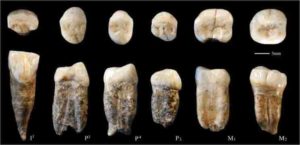
Scientists from the Centro Nacional de Investigación sobre la Evolución Humana (CENIEH) form part of the team which has just published a paper in the journal Scientific Reports, studying for the first time the original fossil remains conserved of “Peking Man.” These six teeth belonging to Homo erectus were found in the mid-twentieth century at the Middle Pleistocene archaeological site of Zhoukoudian (Beijing).
The archaeological and paleontological material (including numerous human remains) at this Chinese site, declared a UNESCO World Heritage, was lost during the Second World War, while it was being shipped to the United States. Currently, there only exist six original teeth, recovered between 1949 and 1959 and in 1966, which are described and compared in this work led by Xing Song, of the Institute of Vertebrate Paleontology and Paleoanthropology (IVPP) of Beijing, in which María Martinón-Torres, director of the CENIEH, and José María Bermúdez de Castro, coordinator of the hominid Paleobiology program, have also participated.
“Since they were lost, for research on the fossil humans found at the site during the 1930s, plaster replicas of very poor quality have been used, as well as the descriptions and sketches that the researcher Franz Weidenreich left us,” comments Bermúdez de Castro.
Homo erectus pekinensis
The human fossils were initially attributed by the Canadian anthropologist Davison Black to the species Sinanthropus pekinensis. Later, in the 1950s, these fossils were included in the species Homo erectus. As Martinón-Torres explains, for a long time the idea was held that this species was a direct ancestor of modern humanity, and “all the human fossils found in what we call the Far East and in the current islands of Indonesia have been attributed systematically to Homo erectus.
Several recent studies point out differences among all these fossils, which are considered as normal variations within the species. According to the authors of this paper entitled “The fossil teeth of the Peking Man,” there are similarities between the teeth of Zhoukoudian and those of other Chinese archaeological sites from a similar period, but they also highlight the differences from other teeth ascribed either to Homo erectus or other species of hominins from Africa and Europe.
It is hoped that this latest work will open the doors definitively to a revision of all the human fossil material from the Far East.
Reference:
Song Xing, María Martinón-Torres, José María Bermúdez de Castro. The fossil teeth of the Peking Man. Scientific Reports, 2018; 8 (1) DOI: 10.1038/s41598-018-20432-y
Note: The above post is reprinted from materials provided by CENIEH.










